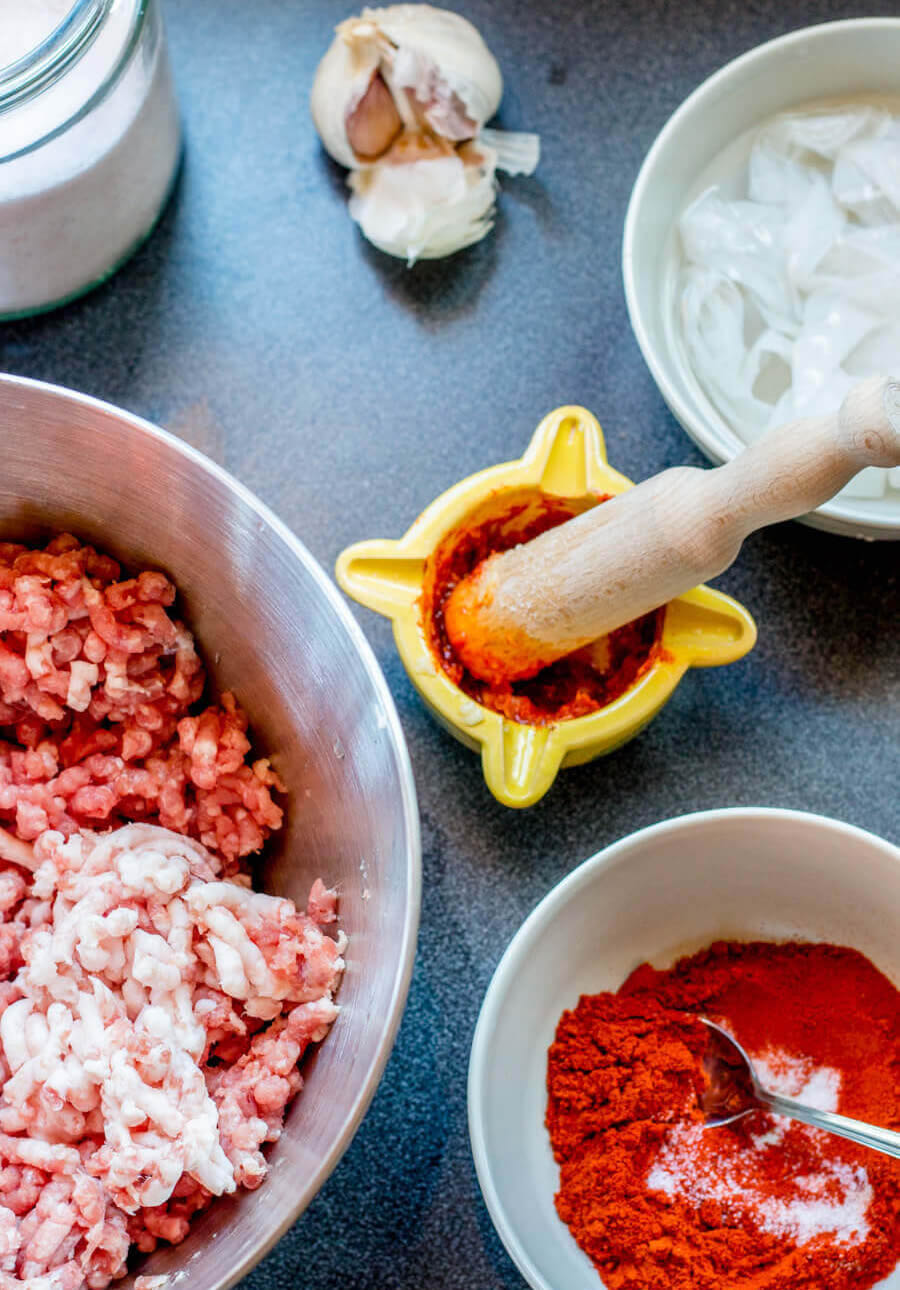Chorizo is arguably Spains most popular sausage and certainly one of my favourites. I love everything Chorizo from its red pimento colour to the way it adds smokey porkey flavour to everything you cook with it and especially the tasty fatty oil it leaves behind after frying!
Depending on how you like to eat your Chorizo, I’m going to explain how to make fresh Chorizo, as the Spanish would eat it, and how to dry cure your sausages so you can have a ready supply to slice thinly and eat with your home made cheeses and breads.
Spanish Chorizo can be made either Sweet or Spicy depending on the region of spain but for this recipe, we’re going to make a spicy Chorizo.

Not only every region of Spain but I’m pretty sure everyone who makes their own dried sausages has their own Spanish Chorizo recipe, but this is the way I like to do mine…
What you’ll need:
2kg boneless shoulder or hand of pork
200g pork back fat
1-2 metres natural sausage casings
5 cloves of garlic
125g smoked hot paprika
75g cayenne pepper
40g salt (around 2% meat weight)
100ml good red wine (optional)
meat mincer & sausage stuffer (optional)

Lets get started
Once you’ve found a good butcher who can supply the back fat and the natural casings, you’ll need to get all your ingredients together and soak the natural sausage casings in fresh cold water.
If you have a mincer and a sausage machine (here’s the all-in-one mincer and sausage stuffer I use) then you can continue to cut up the pork meat and back fat into small cubes to fit easily into your mincer.
If you dont have a mincer don’t worry, just ask your butcher who would be happy to mince the pork and back fat into a coarse mince for you.
Once all the meat is minced and in a nice big bowl, add your Garlic, Paprika, Cayenne Pepper & Salt and get your hands involved and give it a really good mix, making sure to get the dried spices and salt blended right through the mince.
If you’re using red wine, add it once all the dried spices are well incorporated to prevent any spice clumps and keep mixing for 10 minutes or so.
If you’re using a sausage machine, load your casings onto the nozzle and pass through the mince. Prevent any air bubbles by tying a peice of string onto the end cutting off some of the sausage meat then tie off your sausages as long as you want them. I make mine around 6-7 inches which will make around 8 good sized 300g sausages.
If you don’t have a sausage machine, I’ve found a funnel will work. Load the casings on the nozzle and then push the mince down the funnel and into the casings with your fingers. It’s a lot more difficult and time consuming but it does the job.
Once your sausages are securely tied on both ends you can decide whether you’re going to eat your Chorizo fresh or dry cure it to eat it raw.
If you’re eating it fresh, then put your Chorizo in the fridge and leave for a few days for the flavours to mingle then you can cook it to add with your favourite ingredients as you would with any normal sausage.
If you want to dry cure your sausages, you will need to hang them in a warm place, ideally 25–27°C. This will help the good bacteria get off to a good start and begin fermentation.
After about 12 hours in this environment you can move your Chorizo to your dry curing spot which should be between 12 and 18°C with a humidity level of approximately 70% and a constant circulation of fresh air.
Make sure the Chorizo are not touching any walls or eachother and not in direct sunlight.
Now all you have to do is wait.
At this thickness you’ll need to leave your Chorizo drying for about 5-8 weeks, but you can check regularly to see when your Chorizo is firm and dry enough to slice thinly.
Finally after all that waiting you can slice your home made Chorizo thinly and serve with your favourite breads and cheeses, or fry to make wonderfully spicy pastas, salads and stews!